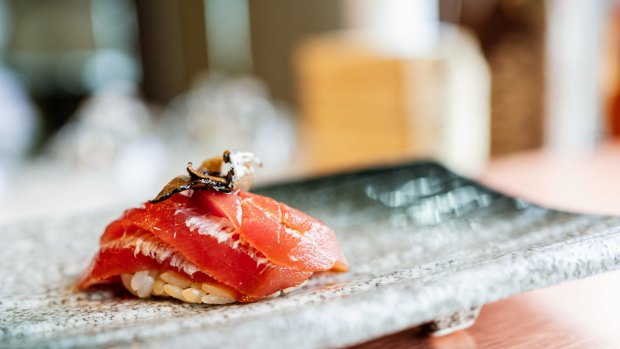This was published 2 years ago
The rules for eating at Japan's best sushi restaurants

You have about 30 seconds from when the sushi hits your plate to eat it. Credit: iStock
There's sushi, and then there's sushi. You will quickly discover this on a trip to Japan. This is a style of cuisine with many different levels – levels of quality, levels of skill, levels of price.
Roughly, however, you can divide Japanese sushi restaurants into three tiers.
It begins at the very cheapest and most cheerful, places that are "kaitenzushi", or conveyor-belt sushi restaurants, similar to the ones we find in Australia, often operating on an all-you-can-eat basis. There's no need for any sort of etiquette or cultural nicety at these places. It's an anything-goes atmosphere.
The next tier is slightly fancier restaurants with bar seating surrounding the kitchen, where sushi is served in set-menu selections. The sushi here will be made fresh in front of you, and served all at once.
And then finally you have the top tier, the fine-dining sushi restaurants, the very expensive omakase-style joints where each piece of nigiri is a work of art. Here, the atmosphere is hushed and reverent. The chef is a star. The food is incredible. And there are a few things you're going to want to keep in mind.
One: no fragrances. Sushi chefs are particular about customers wearing no perfumes or strong scents, the thinking being that the smell will affect the taste of some very expensive fish.
Next thing to bear in mind is that the wooden bar you sit at in a high-end sushi restaurant is usually made of Hinoki cypress, a beautiful timber that is quite soft, and marks easily. So, remove your watch and don't rest your phone on it to avoid scratches.
Now, the food begins arriving. As you may have heard, good sushi is all about the rice, which has to be of high quality, cooked properly, seasoned well, and served at the perfect temperature. That last caveat means that as soon as a piece of nigiri is plonked in front of you, you should eat it. You have about 30 seconds. Go.
And though you will probably want to photograph the food before gobbling it up – this is the pics-or-it-didn't-happen age, after all – some chefs will not be comfortable being snapped. Ask before taking photos.
Bear in mind, too, that in a high-end sushi restaurant, the fish will be seasoned for you, with a tare (sauce) the chefs apply as they see fit. In mid- and lower-tier sushi joints you may have to season your own fish with soy sauce. Just go easy, and only dip the fish, not the rice.
And eat everything. In any restaurant in Japan, it's bad form to order more food than you can eat. Make sure you finish whatever is in front of you.
Though that probably won't be an issue.
Ben Groundwater's new guidebook, "Neon Lights in Tokyo" (RRP $32.99 Hardie Grant), is available now
Sign up for the Traveller Deals newsletter
Get exclusive travel deals delivered straight to your inbox. Sign up now.